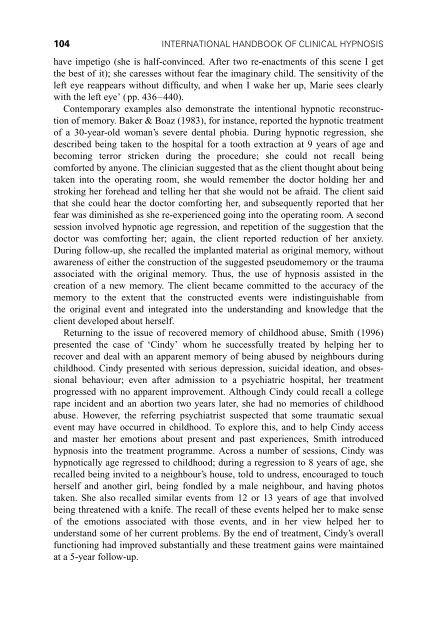International Handbook of Clinical Hypnosis - E-Lib FK UWKS
International Handbook of Clinical Hypnosis - E-Lib FK UWKS
International Handbook of Clinical Hypnosis - E-Lib FK UWKS
Create successful ePaper yourself
Turn your PDF publications into a flip-book with our unique Google optimized e-Paper software.
104 INTERNATIONAL HANDBOOK OF CLINICAL HYPNOSIS<br />
have impetigo she is half-convinced. After two re-enactments <strong>of</strong> this scene I get<br />
the best <strong>of</strong> it); she caresses without fear the imaginary child. The sensitivity <strong>of</strong> the<br />
left eye reappears without dif®culty, and when I wake her up, Marie sees clearly<br />
with the left eye' pp. 436±440).<br />
Contemporary examples also demonstrate the intentional hypnotic reconstruction<br />
<strong>of</strong> memory. Baker & Boaz 1983), for instance, reported the hypnotic treatment<br />
<strong>of</strong> a 30-year-old woman's severe dental phobia. During hypnotic regression, she<br />
described being taken to the hospital for a tooth extraction at 9 years <strong>of</strong> age and<br />
becoming terror stricken during the procedure; she could not recall being<br />
comforted by anyone. The clinician suggested that as the client thought about being<br />
taken into the operating room, she would remember the doctor holding her and<br />
stroking her forehead and telling her that she would not be afraid. The client said<br />
that she could hear the doctor comforting her, and subsequently reported that her<br />
fear was diminished as she re-experienced going into the operating room. Asecond<br />
session involved hypnotic age regression, and repetition <strong>of</strong> the suggestion that the<br />
doctor was comforting her; again, the client reported reduction <strong>of</strong> her anxiety.<br />
During follow-up, she recalled the implanted material as original memory, without<br />
awareness <strong>of</strong> either the construction <strong>of</strong> the suggested pseudomemory or the trauma<br />
associated with the original memory. Thus, the use <strong>of</strong> hypnosis assisted in the<br />
creation <strong>of</strong> a new memory. The client became committed to the accuracy <strong>of</strong> the<br />
memory to the extent that the constructed events were indistinguishable from<br />
the original event and integrated into the understanding and knowledge that the<br />
client developed about herself.<br />
Returning to the issue <strong>of</strong> recovered memory <strong>of</strong> childhood abuse, Smith 1996)<br />
presented the case <strong>of</strong> `Cindy' whom he successfully treated by helping her to<br />
recover and deal with an apparent memory <strong>of</strong> being abused by neighbours during<br />
childhood. Cindy presented with serious depression, suicidal ideation, and obsessional<br />
behaviour; even after admission to a psychiatric hospital, her treatment<br />
progressed with no apparent improvement. Although Cindy could recall a college<br />
rape incident and an abortion two years later, she had no memories <strong>of</strong> childhood<br />
abuse. However, the referring psychiatrist suspected that some traumatic sexual<br />
event may have occurred in childhood. To explore this, and to help Cindy access<br />
and master her emotions about present and past experiences, Smith introduced<br />
hypnosis into the treatment programme. Across a number <strong>of</strong> sessions, Cindy was<br />
hypnotically age regressed to childhood; during a regression to 8 years <strong>of</strong> age, she<br />
recalled being invited to a neighbour's house, told to undress, encouraged to touch<br />
herself and another girl, being fondled by a male neighbour, and having photos<br />
taken. She also recalled similar events from 12 or 13 years <strong>of</strong> age that involved<br />
being threatened with a knife. The recall <strong>of</strong> these events helped her to make sense<br />
<strong>of</strong> the emotions associated with those events, and in her view helped her to<br />
understand some <strong>of</strong> her current problems. By the end <strong>of</strong> treatment, Cindy's overall<br />
functioning had improved substantially and these treatment gains were maintained<br />
at a 5-year follow-up.











![SISTEM SENSORY [Compatibility Mode].pdf](https://img.yumpu.com/20667975/1/190x245/sistem-sensory-compatibility-modepdf.jpg?quality=85)





